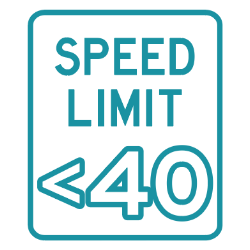Understanding RRFB MUTCD guidelines and best practices
A rectangular rapid flashing beacon (RRFB) is an effective, low-cost solution for pedestrian safety, reducing crashes by 47% and increasing driver yield rates up to 96%.

Pedestrian fatalities at uncontrolled crossings are increasing. The Federal Highway Administration (FHWA) recommends the RRFB as an effective countermeasure and has approved it in the Manual on Uniform Traffic Control Devices (MUTCD).
- Insurance Institute for Highway Safety (IIHS), Fatality Facts 2018: Pedestrians
- Low number: Federal Highway Administration, Effects of Yellow Rectangular Rapid-Flashing Beacons on Yielding at Multilane Uncontrolled Crosswalks, 2010.
High number: Stapleton, Steven et al., Factors Affecting Driver Yielding Compliance at Uncontrolled Midblock Crosswalks on Low-Speed Roadways, 2017.
We need an effective solution to ensure all multi-modal users stay safe.

RRFBs: a proven solution
The rectangular rapid-flashing beacon (RRFB) is a pedestrian-actuated traffic device that warns drivers of crossing pedestrians with high-intensity, rapid-flashing amber LED lights.
- Looking for easy and low-cost installation
Solar requires no trenching for power, no metering, and can be installed by one or two people without extensive equipment. - Distance to existing electrical infrastructure
Trenching for AC can make a project prohibitively expensive. Solar can install almost anywhere without inhibiting traffic or damaging the landscape. - Sustainability initiatives are in place
Solar-powered beacons are an easy-to-implement way to achieve sustainability goals. The Federal Highway Administration (FHWA) also encourages solar beacons, where possible.
RRFBs were designed to loosely mimic the visual effect of emergency vehicle lights like ambulances. RRFBs use higher intensity lights with a quick flash pattern, making then highly visible when competing with other traffic signals, headlight glare, or wet roads.
They use a wig-wag plus simultaneous (WW+S) flash pattern, as required by the FHWA, to quickly grab drivers’ attention.

The essential safety stats
Let’s break down what the research has discovered about RRFB effectiveness.
Circular beacons vs. RRFBs
An experiment in St. Petersburg, Florida, found that RRFBs increased driver yield rates significantly more than a standard circular flashing beacon.
Circular flashing beacons were only slightly more effective than marked crosswalks and warning signs.
Why the increase?
- Different shape
- Unique, rapid flashing pattern
- Brighter intensity
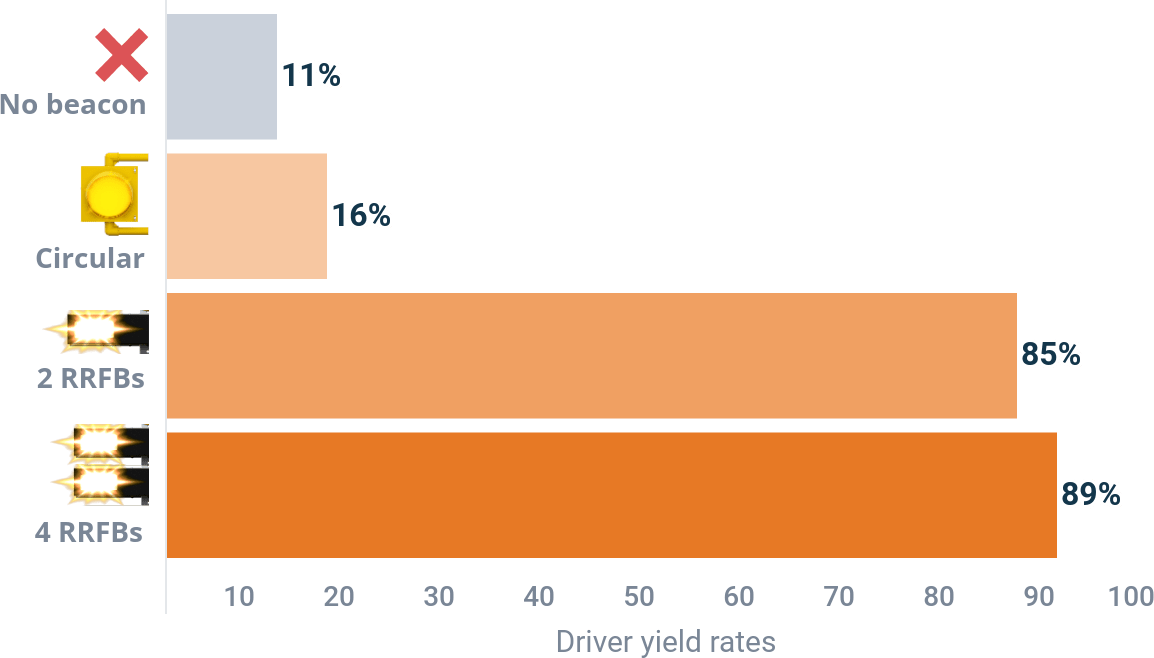
U.S. Department of Transportation Federal Highway Administration, Report No. FHWA-HRT-10-043, Effects of Yellow Rectangular Rapid-Flashing Beacons on Yielding at Multilane Uncontrolled Crosswalks
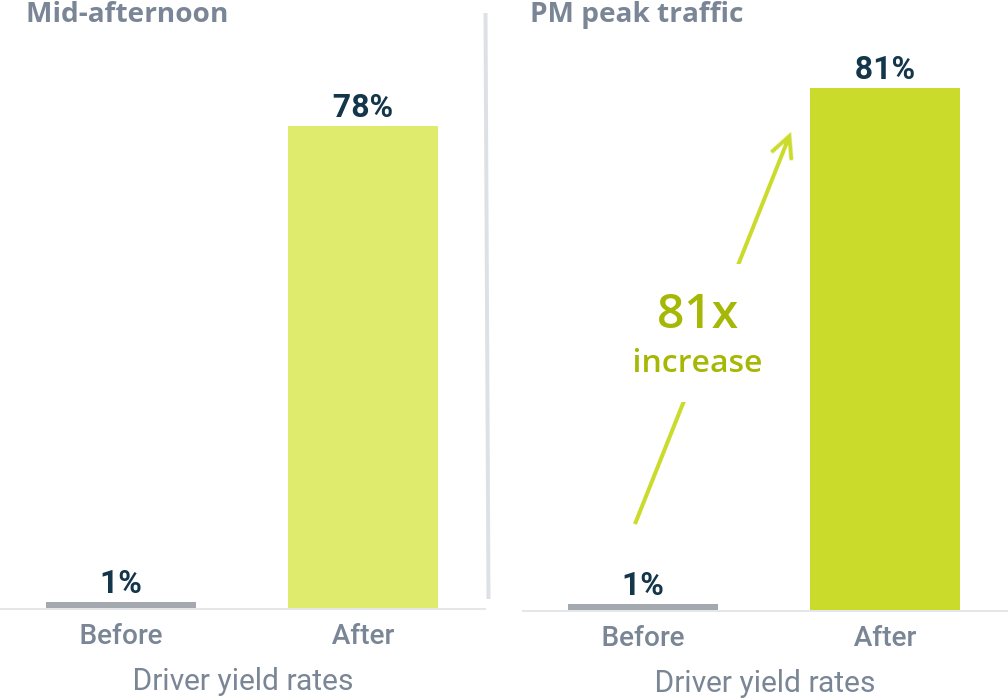
Technical Memorandum to City of Garland Department of Transportation, Before-and-After Study of the Effectiveness of Rectangular Rapid-Flashing Beacons used with School Sign in Garland, Texas
RRFBs in school zones
An experiment in Garland, Texas, found that RRFBs installed in a school zone substantially increased driver yield rates.
Yield rates before RRFB installation were as low as 1% and less. After installation, they increased to 78% and 81%.
Long-term effectiveness
Two experiments in St. Petersburg, Florida, reported that the safety effect of RRFBs on driver yield rates did not fall off after months of sustained use. In fact, some sites had higher yield rates 14 months after the initial test.
Experiment A
Researchers studied 4 RRFB sites and compared yield rates before and after installation, then repeated the test 14 months later.
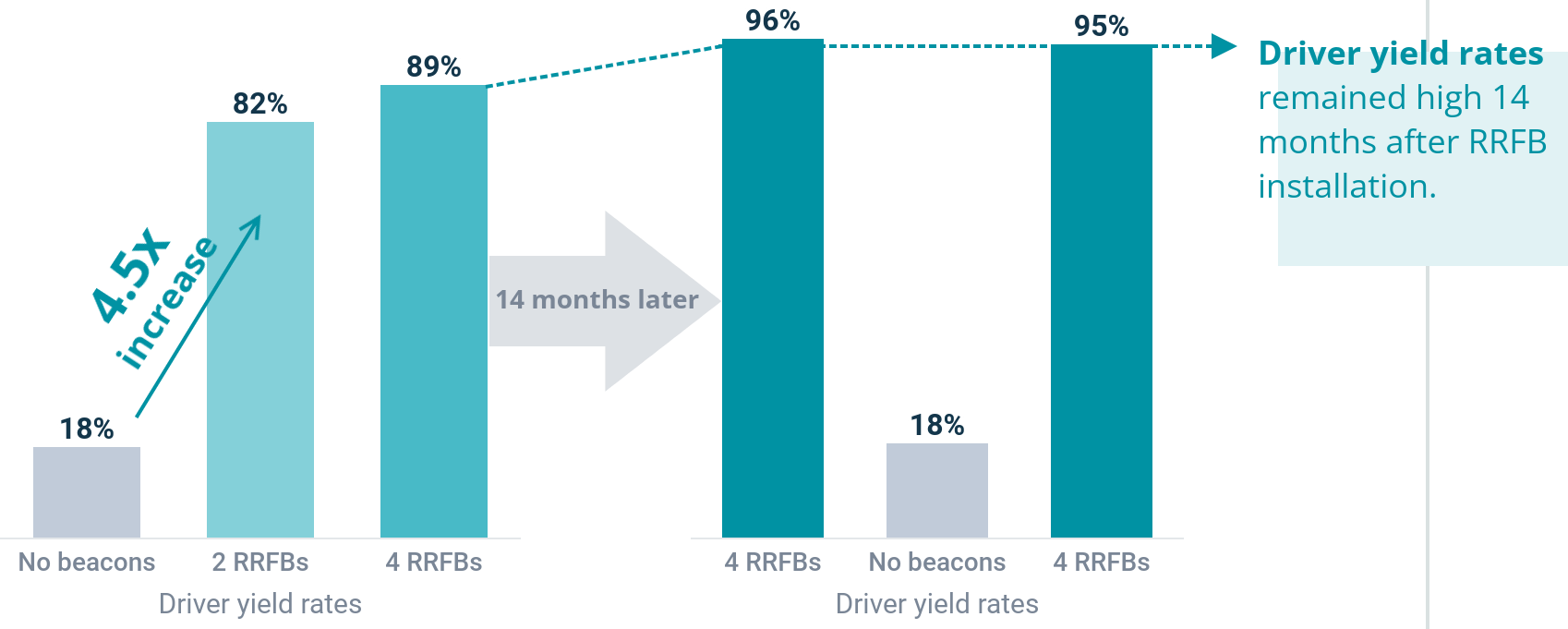
U.S. Department of Transportation Federal Highway Administration, Report No. FHWA-HRT-10-043, Effects of Yellow Rectangular Rapid-Flashing Beacons on Yielding at Multilane Uncontrolled Crosswalks
Experiment B
This experiment evaluated RRFBs across 19 different sites on roads with a variety of lanes, traffic flow, and annual average daily traffic over the course of 2 years.
Researchers found significantly high driver yield rates sustained over the long-term.
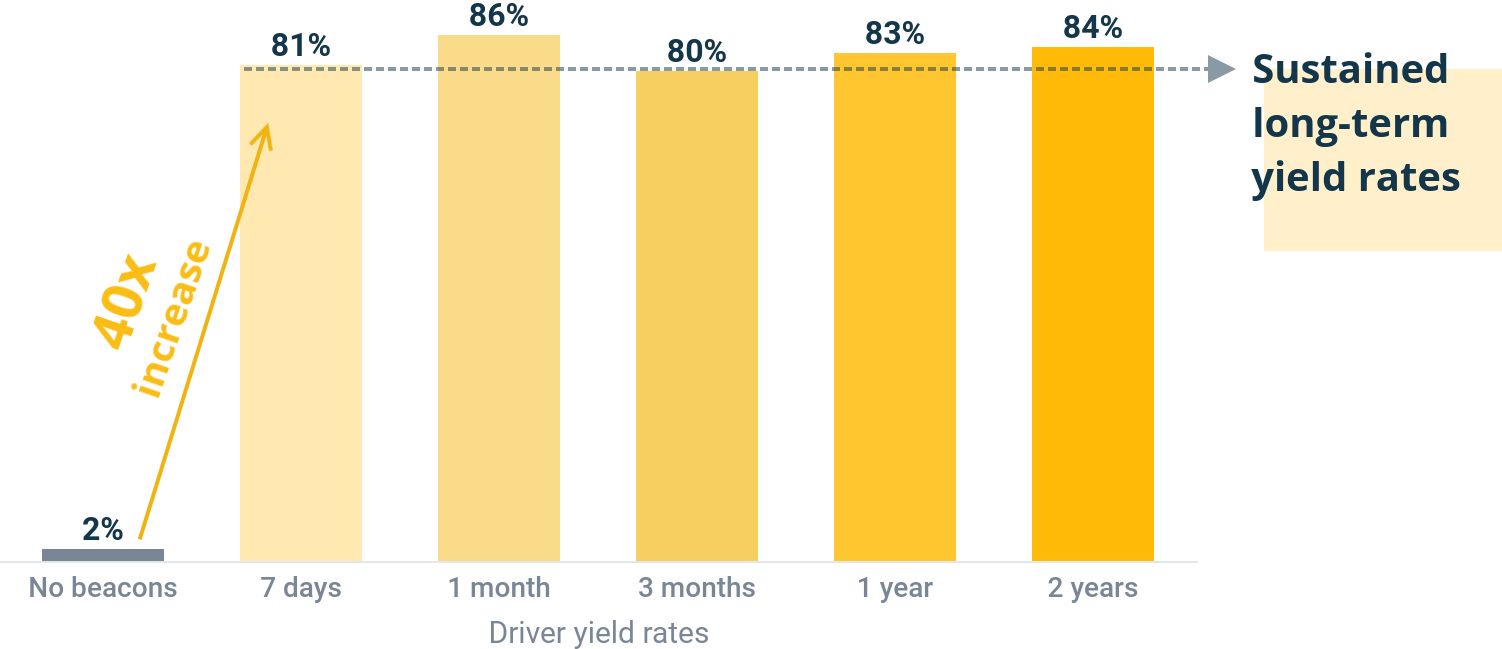
U.S. Department of Transportation Federal Highway Administration, Report No. FHWA-HRT-10-043, Effects of Yellow Rectangular Rapid-Flashing Beacons on Yielding at Multilane Uncontrolled Crosswalks
Geographic differences
RRFBs have been tested in a vast range of studies across the US and Canada, showing the same relative effect on driver yield rates.

Where RRFBs work best
The FHWA has synthesized research on RRFB effectiveness alongside other crosswalk safety countermeasures to create a selection matrix to help municipalities choose an appropriate treatment.
You can find the matrix as well as other tips for evaluating crosswalk safety countermeasures with FHWA’s Safe Transportation for Every Pedestrian (STEP) resource.
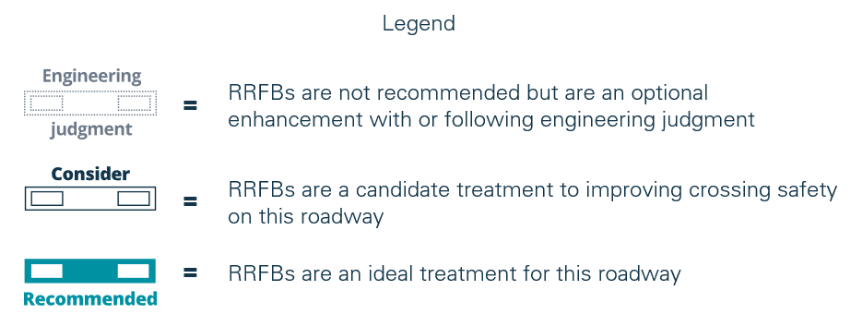

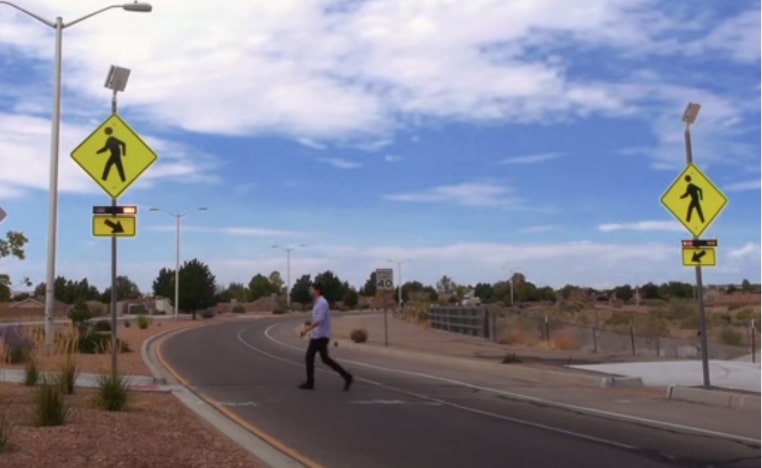
1. Rio Rancho, NM, roadway
2 lanes, median present, < 9,000 AADT,
40 mph posted speed limit = RRFB recommended
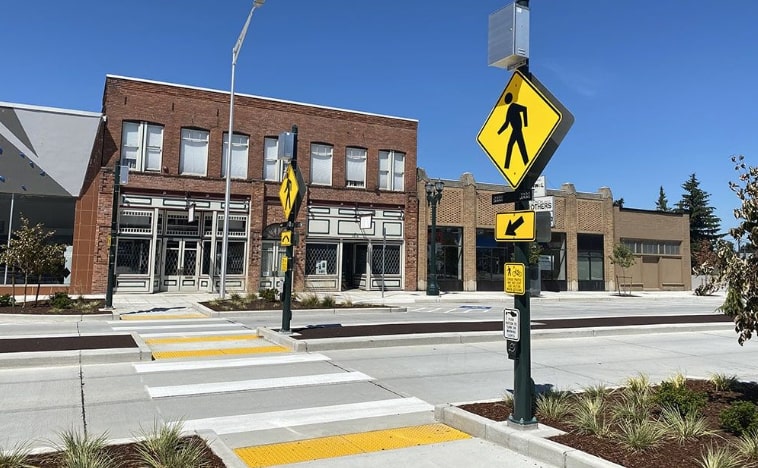
2. Everett, WA, roadway
2 lanes, median present, < 15,000 AADT,
30 mph posted speed limit = RRFB recommended
Part 2: MUTCD Chapter 4L
Effective December 2023, RRFBs are officially recognized as approved enhancements for marked crosswalks at uncontrolled approaches. Detailed standards, guidance, and options are outlined in Chapter 4L of the 11th Edition of the MUTCD.
Beacon flashing
Flash pattern
The RRFB shall flash in a wig-wag plus simultaneous (WW+S) flash pattern.
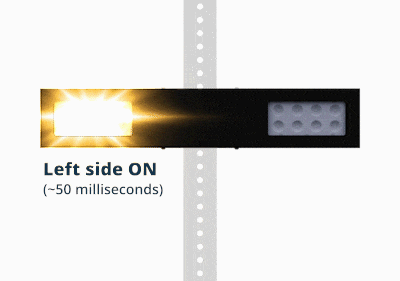
Nighttime dimming
To minimize excessive glare at night, automatic signal dimming should be used.
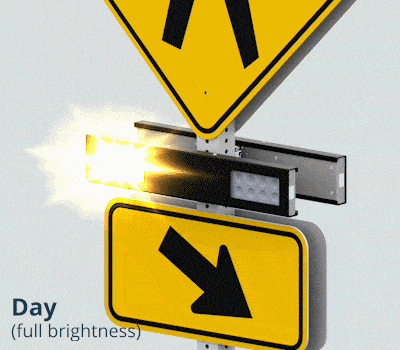
Allowable uses
Allowed signs
The RRFB shall only be used to supplement the following post-mounted or overhead-mounted signage located at or immediately adjacent to an uncontrolled marked crosswalk:
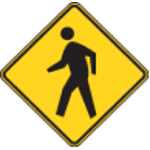
W11-2 pedestrian crossing sign
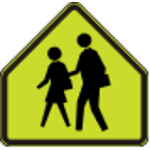
S1-1 school zone crossing sign
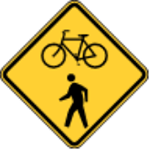
W11-15 bicycle / pedestrian crossing sign
Plaque
Pair signs with a W16-7P diagonal downward arrow plaque.


Prohibited signs
RRFBs shall not be used for crosswalks controlled by YIELD signs or STOP signs (except at roundabouts).

R1-1 stop sign
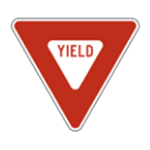
R1-2 yield sign
Beacon dimensions and mounting
Light bar dimensions
Each RRFB indication shall be a minimum of 5 inches wide by 2 inches high and aligned horizontally with a minimum space of 7 inches in between.
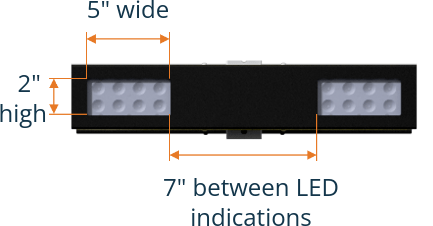
Light bar mounting
An RRFB supplementing a post-mounted sign and plaque may be mounted either directly below the crossing warning sign (and above the plaque) or within 12 inches above it.
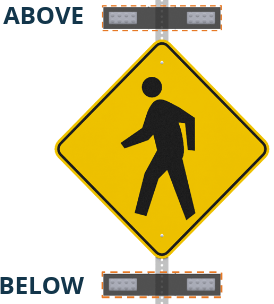
Pedestrian detection
Pushbutton signage
If pedestrian pushbutton detectors are used, a Push Button To Turn On Warning Lights (R10-25) sign shall be installed explaining the purpose and use of the pushbutton.
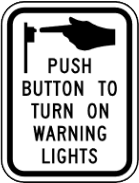
Speech pushbutton
If a speech pushbutton message is used, a locator tone shall be provided, shall not use vibrotactile indications, and should speak ”Yellow lights are flashing” twice

Mounting height
Sign mounting
The W16-7P plaque shall be mounted below the crossing sign and the RRFB light bar at a minimum of 7 feet from the bottom of the plaque to the sidewalk.
Pushbutton mounting
For ADA compliance, the pushbutton shall be installed at a height of approximately 3.5 feet and no higher than 4 feet.

Additional resources for RRFBs
Article
An Overview of the Most Effective Crosswalk Treatments: Weighing your options for an unsignalized crossing? Here’s a roundup of your treatment options and how they compare.
Product
Find an RRFB product.
Guide
RRFB Application Guide: Download this visual guide for the most common RRFB placements and installations at marked, uncontrolled mid-block crosswalks.
Article
An Overview of the Most Effective Crosswalk Treatments: Weighing your options for an unsignalized crossing? Here’s a roundup of your treatment options and how they compare.
Product
Find an RRFB product.
Guide
RRFB Application Guide: Download this visual guide for the most common RRFB placements and installations at marked, uncontrolled mid-block crosswalks.
